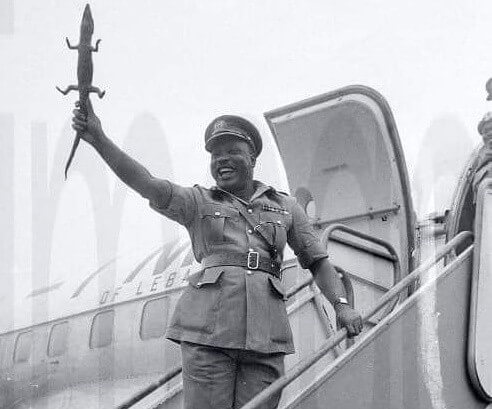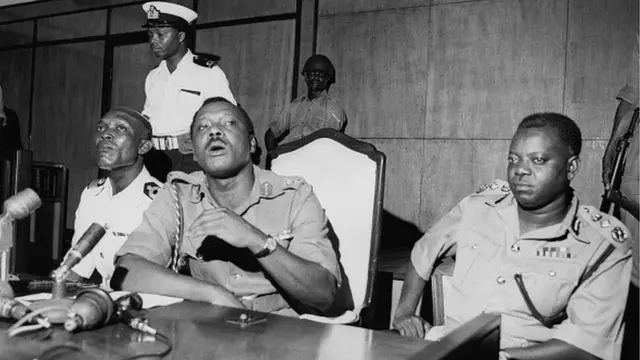On 15 January 1966, rebellious soldiers led by Kaduna Nzeogwu and 4 others carried out a military putsch, killing 22 people, including the prime minister of Nigeria, many senior politicians, senior Army officers and their wives, and sentinels on protective duty.
The coup plotters attacked the cities of Kaduna, Ibadan, and Lagos while also blockading the Niger and Benue River within a two-day timespan, before being overcome by loyalist forces.

The General Officer Commanding the Nigerian Army, Johnson Aguiyi-Ironsi, was falsely accused of having been compelled to take control of the government of a country in upheaval, inadvertently putting Nigeria’s nascent democracy on hold. His ascendancy to power was deemed a conspiracy by the coup plotters, who were partly Igbo and Majors from Yoruba and Hausa sub regions, to pave the way for General Aguiyi-Ironsi to be head of state of Nigeria. Consequently, the retaliatory events by Northern members of the Nigerian Army that led to deaths of many Igbo soldiers and civilians put the nation on a path that eventually led to a civil war.
BACKGROUND
In August 1965, a group of Army majors (Emmanuel Ifeajuna, Timothy Onwuatuegwu, Chris Anuforo, Don Okafor, Humphrey Chukwuka, and Adewale Ademoyega) began plotting a coup d’état against incumbent Prime Minister Abubakar Balewa. The coup was planned because according to the majors, the men at the helm of affairs were running Nigeria aground with their corrupt ways. Ministers under them were living flamboyant lifestyles and looting public funds at the expense of ordinary citizens.

Furthermore, Captain Ben Gbulie and Colonel Emmanuel Nwobosi, who participated in the coup, later claimed that another reason for the 15 Jan coup was to counter a “Jihad” that was planned to happen by 17th January.
THE PRESIDENT OF NIGERIA, NNAMDI AZIKIWE
left the country in late 1965, first for Europe, then on a cruise to the Caribbean. Under the law, the Senate president, Nwafor Orizu, became acting president during his absence and assumed all the powers of the office.
COUP
In the morning of 15 January 1966, at a meeting with some local journalists in Kaduna seeking to find out what was going on, it was brought to Major Nzeogwu’s attention that the only information about the events then was what was being broadcast by the BBC. Nzeogwu was surprised because he had expected a radio broadcast of the rebels from Lagos. He is said to have “gone wild” when he learnt that Emmanuel Ifeajuna in Lagos had not made any plans whatsoever to neutralize Johnson Aguiyi-Ironsi who was the Commander of the Army. Therefore, Nzeogwu hurriedly drafted a speech which was broadcast on Radio Kaduna sometime around 12 a.m. and in which he declared martial law over the Northern Provinces of Nigeria.
 AFTERMATH
AFTERMATH
Acting President Nwafor Orizu made a nationwide broadcast, after he had briefed President Nnamdi Azikiwe on the phone about the decision of the cabinet, announcing the cabinet’s “voluntary” decision to transfer power to the armed forces. Major General Johnson Aguiyi-Ironsi then made his own broadcast, accepting the “invitation”. On 17 January, Major General Ironsi established the Supreme Military Council in Lagos and effectively suspended the constitution.

Some days after the coup, the majority of the people across the country were indifferent about the coup, but as more information came forth, different reactions begin to build up.
This event was later tagged an “Igbo coup” by other ethnic groups in the country based on the following:
The killing patterns – only Arthur Unegbe of the 22 casualties is of Igbo origin, while notable Igbo politicians like the Premier of Eastern region and military personnel like Ironsi were unharmed.
The handing over of the government to Ironsi by Orizu (the acting president and the senate president who could have called for the formation of another civilian government) made it look like it was planned out all along.
The unification decree of May 1966 promulgated by Ironsi, leading to the abolition of regional system of government – Historically speaking, the West and North have always believed in the regional system of government as the best form of government for a multi-ethnic country like Nigeria, however this was taken away by Ironsi, leading to a massive outrage and pogrom in the North in May 1966.
This happened a few months before the counter coup by Northern soldiers, which lead to the death of Ironsi, Fajuyi and many officers of Igbo origin.
The coup plotters, though kept in jail, were never court-martialled and punished according to military procedure. On other occasions unsuccessful coups meant death of the plotters, including the coup attempts under Obasanjo and Babangida
Other participants of the coup including Major Ademoyega, a Yoruba, Captain Ben Gbulie, Colonel Nwobosi, and others later came out to refute the idea that it was an “Igbo coup” through book publications and interviews.
CASUALTIES
Regarding the casualties, the coup conspirators claimed their purge post-coup targeted members or supporters of the anterior regime and had been targeted for purely political reasons instead of being a racial purge focused on certain ethnic groups or clans; furthermore, they also claimed the list of people targeted was small and composed of only 8 people, half of them foreigners who were to be arrested not killed, and that the casualties had occurred as collateral damage of the coup. These claims were clarified by a member of the trio that formed the coup, Adewale Ademoyega, who published them in Nigeria in 1981 in a book titled Why We Struck outlining their reasons and motivations in which he mentioned:

There was no decision at our meeting to single out any ethnic group for elimination. Our intentions were honourable, our views were national and our goals were idealistic. Even those earmarked for arrest, four were northerners, two were Westerners and two were Easterners.
Below is a comprehensive list of casualties from the coup.
CIVILIANS
- Prime Minister Abubakar Tafawa Balewa
- Premier Ahmadu Bello
- Premier Samuel Ladoke Akintola
- Finance Minister Festus Okotie-Eboh
- Ahmed Ben Musa (Bello’s Senior Assistant secretary for Security)
- Hafsatu Bello(wife of Ahmadu Bello)
- Latifat Ademulegun, wife of General Ademulegun.
- Zarumi Sardauna
- Ahmed Pategi (Bello’s driver)
MILITARY AND POLICE
- Brigadier Samuel Ademulegun
- Brigadier Zakariya Maimalari
- Colonel Ralph Shodeinde
- Colonel Kur Mohammed
- Colonel Abogo Largema
- Colonel James Pam
- Colonel Arthur Unegbe
- Sergeant Daramola Oyegoke
- PC Yohana Garkawa
- Lance-corporal Musa Nimzo
- PC Akpan Anduka
- PC Hagai Lai
- Philip Lewande
CULLED FROM WIKIPEDIA


